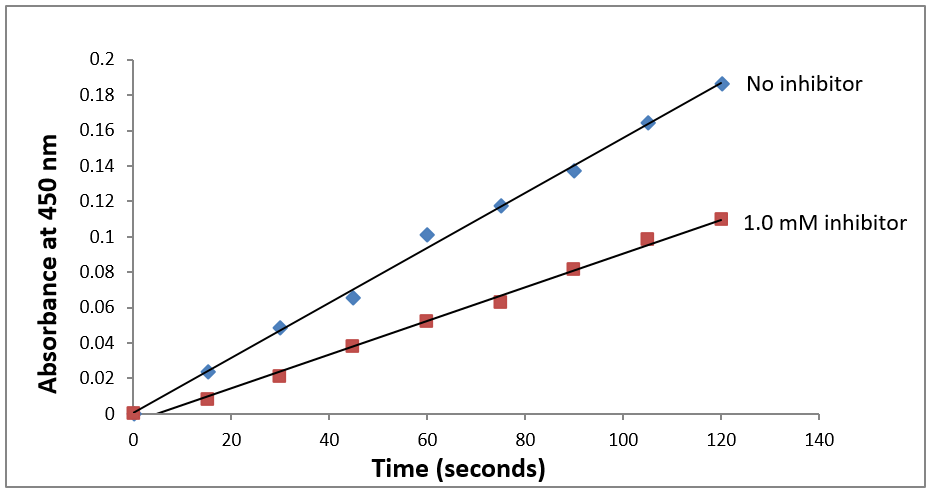Background Part 2
Enzyme Assays
Lecture Video
An assay is an analytical method used to detect the presence, absence, or quantity of some component in a sample. Enzyme assays are designed to reveal and quantitate a specific enzyme-catalyzed reaction. They can also be used to detect how much of an enzyme is present in a given sample, used to determine kinetic constants (Lab 6), used to identify enzyme mechanisms, in addition to exploring other characteristics of an enzyme. An assay requires that all cofactors (metal ions, organic compounds, etc.) are present and in saturating amounts. It is also important that inhibitors of the enzyme are not present during the assay. A proper pH must be maintained, and in many cases assays are conducted at a pH optimum for the catalyzed reaction. Temperature, ionic strength, and the type of buffer are also controlled and should be optimized. A method of identifying the products or reactants is also necessary. These methods can include spectrophotometry, titrations, use of radioisotopes, isolation of products, fluorimetry, etc.

Figure 2 Sample initial rate data for a hypothetical enzyme. Data was acquired with 5.0 mM substrate and 1 µg/mL imaginase at 23 °C by following absorbance at 450 nm. The trendlines for data with 1.0 mM inhibitor (squares, □) and without inhibitor (diamonds, ◊) are y = (0.971×10-4 s-1) x + (4.73×10-3 s-1) [R2 = 0.995] and y = (15.2×10-4 s-1) x + (5.10×10-4 s-1) [R2 = 0.997] respectively.
This week, we will spectrophotometrically monitor product accumulation continuously at 475 nm over time in the presence of a saturating concentration of substrate (L-Dopa). The absorbance of the sample can be related to the concentration of the formed product by the Molar absorptivity in Beer's Law.

The rate of reaction will be determined by the slope of the best straight trendline that fits our data. As shown below, the amount of dopachrome product formed per unit time can be directly translated as the activity of the enzyme.
Enzyme Units
An enzyme unit is defined as the amount of the enzyme that produces a certain rate of enzymatic activity. The enzyme unit U, adopted by the International Union of Biochemistry in 1964, is defined as the amount of enzyme that catalyzes the conversion of 1 micro mole of substrate per minute.13 The conditions must be specified, particularly temperature, pH value, substrate identity, and concentration used in assay. Remember to specify these in your reports.
Enzyme activity (U) = μmol of substrate reacted per min
Unfortunately, the minute is not an SI unit, so it should be of no surprise that the enzyme unit is discouraged in favor of the modern SI unit katal. One katal is the amount of enzyme that converts 1 mole of substrate per second.13 However, because this unit is inconveniently large it is rarely used and enzyme units U are preferred.
Note that the enzyme activity unit is defined as an amount of enzyme, not actually a rate unit. The reason it is used to effectively express rates is because enzymes are catalysts, thus their presence speeds up a reaction. The observed rate of a catalyzed reaction is dependent on the intrinsic rate constant k as a function of the concentration of the enzyme:
Observed Rate (μM/min) = k (molecules of substrate per min) × moles of enzyme (μmol) / volume (L)
Since the amount of enzyme is directly proportional to reaction rate, it can substitute for a rate unit because, the actual molar concentration of active enzyme molecules in a preparation is rarely known precisely. The first reason is that other inactive proteins may be present. However, even if you laboriously purify the enzyme, the activity of any given sample is often variable either due to denaturation during the isolation process or the requirement for some activating modification of the enzyme. Additionally, repeated freeze and thaw cycles tend to reduce the fraction of active enzyme protein molecules which means that amount of active enzyme may vary from day to day for the same preparation. It is usually not worth the effort to establish the amount of active enzyme molecules in a sample since most experiments in biochemistry only require relative, not absolute activity. For this reason, one enzyme unit generally serves as a relative measurement of observed rate known as "activity."
In our experiment, we cannot conveniently observe disappearance of the L-Dopa substrate, thus we will calculate our units based on the rate of appearance of orange dopachrome product. Details for the calculation of our enzyme units are explained in the Analysis section on page 5 of this lesson. The pre-lab quiz will include one calculation question. Please read the Analysis sectionof this lesson before attempting the quiz.
Your Leninger textbook introduces the concepts of enzyme units, activity, and specific activity in Section 3.3 in the subsection Unseparated Proteins Are Detected and Quantified Based on Thier Functions.